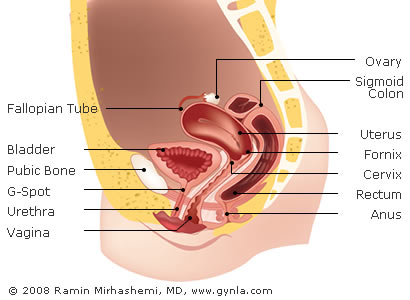The vagina is a cylindrical canal leading from the cervix to the outside. During labor, the baby travels from the uterus through the vagina to the outside.
Vaginal cancer is one of the least common gynecologic malignancies. Because this cancer is more common in post menopausal women it is of utmost importance for this patient group to see their gynecologist annually. If caught early, vaginal cancer is curable.
There are two main types of vaginal cancers:
- Squamous cell carcinoma: This is the most common type and forms in the thin flat cells (squamous cells) that line the surface of the vagina. This is a slow growing cancer that commonly affect post menopausal women.
- Adenocarcinoma: This type of vaginal cancer begins in glandular (secretory) cells. Glandular cells in the lining of the vagina make and release fluids such as mucus which is important for lubrication during intercourse. Adenocarcinoma is more likely than squamous cell cancer to spread to the lungs and lymph nodes. It is found most often in women aged 30 or younger.

RISK FACTORS
The risk factors for vaginal cancer include:
- Age 60 or older.
- Exposure to DES while in the mother's womb. In the 1950s, the drug DES was given to some pregnant women to prevent miscarriage (premature birth). Women who were exposed to DES before birth have an increased risk of developing vaginal cancer. Some of these women develop a rare form of cancer called clear cell adenocarcinoma.
- Having human papilloma virus (HPV) infection.
- Having a history of abnormal cells in the cervix or cervical cancer.
SYMPTOMS
Unfortunately, vaginal cancer does not always cause symptoms and may be identified during a routine pap test. Some symptoms that are seen in patients with vaginal cancer include:
- Bleeding or discharge not related to menstrual periods.
- Pain during sexual intercourse.
- Pain in the pelvic area.
- A lump in the vagina.
TREATMENT
Three forms of treatment may be considered for women with vaginal cancer. The choice is dependent on the stage of cancer and patient desires. Dr. Mirhashemi will determine the best choice for you based on the physical examination and of course in consultation with you, will determine the best options.
1. Surgery
Surgery is the most common treatment of vaginal cancer. The following surgical procedures may be used:
- Laser surgery: A surgical procedure that uses a laser beams (a narrow beam of intense light) as a knife to make bloodless cuts in tissue.
- Wide local excision: A surgical procedure that takes out the cancer and some of the healthy tissue around it (margins)
- Vaginectomy: Surgery to remove all or part of the vagina.
- Total hysterectomy: A surgery to remove the uterus, including the cervix. If the uterus and cervix are taken out through the vagina, the operation is called a vaginal hysterectomy. If the uterus and cervix are taken out through a large incision (cut) in the abdomen, the operation is called a total abdominal hysterectomy. If the uterus and cervix are taken out through a small incision in the abdomen using a laparoscope, the operation is called a total laparoscopic hysterectomy.
- Lymphadenectomy: A surgical procedure in which lymph nodes are removed and checked under a microscope for signs of cancer. This procedure is also called lymph node dissection. If the cancer is in the upper vagina, the pelvic lymph nodes may be removed. If the cancer is in the lower vagina, lymph nodes in the groin may be removed.
- Pelvic exenteration: This type of surgery is reserved for patients with advanced stage vaginal cancer (stage 4) or patients who have a recurrence of their vaginal cancer despite the conventional treatments. Dr. Mirhashemi is a world expert in exenterative procedure and the reconstruction that is required.Pelvic exenteration surgery removes the lower colon, rectum, and bladder. In women, the cervix, vagina, ovaries, and nearby lymph nodes are also removed. Artificial openings (stoma) are made for urine and stool to flow from the body into a collection bag.
Skin grafting may follow surgery, to repair or reconstruct the vagina. Skin grafting is a surgical procedure in which skin is moved from one part of the body to another. A piece of healthy skin is taken from a part of the body that is usually hidden, such as the buttock or thigh, and used to repair or rebuild the area treated with surgery.
Even if Dr. Mirhashemi removes all the cancer that can be seen at the time of the surgery, some patients may be given radiation therapy after surgery to kill any cancer cells that are left. Treatment given after the surgery, to increase the chances of a cure, is called adjuvant therapy.
2. Radiation therapy
Radiation therapy is a cancer treatment that uses high-energy x-rays or other types of radiation to kill cancer cells or keep them from growing. There are two types of radiation therapy. External radiation therapy uses a machine outside the body to focus the radiation in the direction of the cancer. Internal radiation therapy or brachytherapy uses a radioactive substance sealed in needles, seeds, wires, or catheters that are placed directly into or near the cancer. The way the radiation therapy is given depends on the type and stage of the cancer being treated.
3. Chemotherapy
Chemotherapy is a cancer treatment that uses medicines to stop the growth of cancer cells, either by killing the cells or by stopping them from dividing. When chemotherapy is taken by mouth or injected into a vein or muscle, the drugs enter the bloodstream and can affect cancer cells throughout the body The way the chemotherapy is given depends on the type and stage of the cancer being treated. Topical chemotherapy for squamous cell vaginal cancer may be applied to the vagina in a cream or lotion.







